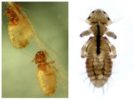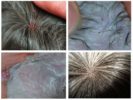- Lice eaters
- Guinea pig lice
- Spray Front Line
- Collar Celandine
Anyone who has decided to have a guinea pig should know that hairworms can be found in her hair - insects from the detachment of the lice, feeding on epidermal scales and secretions of glands. The presence of parasites on the skin of the pet gives him great discomfort in the form of itching and even hair loss. Therefore, if water-eaters are found in guinea pigs, urgent measures must be taken to control pests.
Parasite features
The question of what the whipworms look like, worries every owner who has found living creatures in the hair of his pet. The parasite has a flattened body, which consists of segments covered with bristles. Its length does not exceed 2 mm. Against the background of dark hair, the parasite looks slightly yellowish, in white wool it appears gray.
On the large head of the lice-bearer, the shape of which resembles a shield, in addition to the eyes and the jointed antennae, there is a gnawing mouth apparatus. Powerful jaws covered with denticles. On the chest there are 3 pairs of paws that end in claws. The combination of such clings and teeth on the jaws makes it possible for the insect to stay on woolen hairs. A photo of the guinea pigs ’beetles is presented below.

Pests breed very quickly: one female lays up to hundreds of eggs, which are glued to the guinea pig’s fur with the help of a special substance secreted by the glands. After about a week, larvae appear from them, which differ from adults in smaller size. In the process of growth, the larva undergoes 3 molting, which takes about three weeks.
Methods and symptoms of infection
Lice beetles are more active in the cold season, when the conditions for their living are as comfortable as possible - the hair of guinea pigs becomes thicker and longer. If the pet is kept in a clean cage, then the risk of infection with parasites is small. Usually, the external environment acts as a source of infection: lice-eaters can be transmitted to a furry pet in contact with another animal or during a walk. Another method of infection with parasite larvae may be sawdust or hay purchased at the store.
Symptoms in guinea pigs indicating the presence of lice eaters are as follows:
- Itching is the main sign of the presence of pests in the hair of a pet. The animal constantly itches, he constantly bites his fur, trying to gnaw off the parasite. Subsequently, abrasions, wounds and crusts appear on the surface of the skin.
- The rodent becomes very restless, it loses its appetite and sleep, which can lead to a decrease in immunity, the development of anemia and vitamin deficiency.
- The crawling water-eaters and their eggs can be seen with the naked eye if the pet's fur is moved apart.

Important!
Lice-eaters pose a serious danger to guinea pig, as they carry various diseases, including helminthiasis, fungus, viruses and bacteria. However, it’s not worth worrying that the parasites will pass to its owner - human beetles cannot be, as parasites of animals are not transmitted.
Treatment and prevention
Do not panic when parasites are found in the rodent's hair. Today, there are plenty of drugs available to kill pests. Remedies for moisture guinea pigs are in the form of:
- sprays, a drop;
- emulsions, shampoos;
- collars and powders.
Spray
Effectively fight the pest with the help of sprays. They are based on insecticidal components and have a simple method of application. It is enough to spray the rodent's hair with a solution, and then rub it over the entire surface of the skin with massage movements. Most often, just one aerosol treatment is enough to completely rid the guinea pig of parasites. An example of such a tool is Front Line Spray.

Drops
Treatment in guinea pigs from moisture-eating is also carried out with drops containing an insecticide. The drug helps to get rid of not only lice-eaters, but also ticks, lice and other skin parasites. The solution is dripped onto the spine in the neck so that the rodent cannot reach it. Such funds are the most effective, as they not only destroy the beetles, but also prevent their re-distribution. Drops of Stronghold, Bars, Advantage or Green Fort brands are in special demand among consumers.
Emulsions
Emulsion is another cure for lice eaters. The concentrated suspension is diluted with water in accordance with the manufacturer's recommendations. It is treated with animal hair. Many consumers prefer Neostomozan.
Shampoos
Shampoos are ways to treat guinea pigs more safely. Such detergents are preferable to use for preventive purposes. Since it is not always possible to achieve complete destruction of insects after one application. Shampoos of Lugovoi, Lesnoy or Phytoelite are very popular among consumers.
Collars
Collars not only eliminate pests, but also prevent re-infection of guinea pigs with the guinea pigs. The disadvantage of this accessory is the possibility of an allergic reaction and irritation in the pet.

Powder
Powdered powder in the form of powder can not only relieve pests, but also cure the inflammatory process on the skin, as well as reduce the sensation of itching. Powder is sprinkled on the body of a rodent, trying to rub it into the skin as much as possible. The effect of the drug lasts for a week and a half.
In order to get rid of the gnats, it is necessary to process not only the guinea pig, but also the cage in which it is contained. A similar procedure should also be subjected to household items with which the animal is in contact. To do this, you can use Butox 50 solution.







